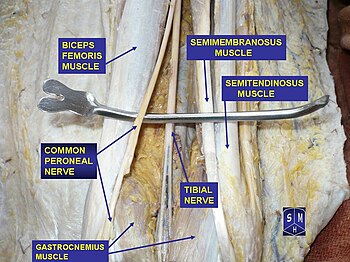Sciatic nerve
| Sciatic nerve | |
|---|---|
L4-S3) | |
| To | Tibial and common fibular nerve |
| Innervates | Lateral rotator group (except piriformis and quadratus femoris) and the posterior compartment of thigh |
| Identifiers | |
| Latin | nervus ischiadicus |
| MeSH | D012584 |
| TA98 | A14.2.07.046 |
| TA2 | 6569 |
| FMA | 19034 |
| Anatomical terms of neuroanatomy] | |
The sciatic nerve, also called the ischiadic nerve, is a large
Structure
In humans, the sciatic nerve is formed from the L4 to S3 segments of the sacral plexus, a collection of nerve fibres that emerge from the
- The posterior compartment of the leginto the foot
- The common peroneal nerve), which travels down the anterior and lateral compartments of the leginto the foot
The sciatic nerve is the largest nerve in the human body.[1]: 422–4 [2][3]


Development
This Section needs attention from an expert in Biology or Anatomy. The specific problem is: Adequate information with reliable citations is not available. (February 2023) |
This section needs expansion. You can help by adding to it. (March 2014) |
Function
The sciatic nerve supplies sensation to the skin of the foot, as well as the entire lower leg (except for its inner side). Sensation to skin to the sole of the foot is provided by the tibial nerve, and the lower leg and upper surface of the foot via the common fibular nerve.[1]: 422–4
The sciatic nerve also innervates muscles. In particular:[1]: 422–4
- Via the posterior compartment of the leg and sole of the foot (plantar aspect).[a]
- Via the lateral compartments of the leg.[b]
Clinical significance
Sciatica
Pain caused by a compression or irritation of the sciatic nerve by a problem in the lower back is called
Injury
Sciatic nerve injury occurs between 0.5% and 2.0% of the time during a hip replacement.[6] Sciatic nerve palsy is a complication of total hip arthroplasty with an incidence of 0.2% to 2.8% of the time, or with an incidence of 1.7% to 7.6% following revision.[7] Following the procedure, in rare cases, a screw, broken piece of trochanteric wire, fragment of methyl methacrylate bone cement, or of a Burch-Schneider antiprofusio cage can impinge on the nerve; this can cause sciatic nerve palsy which may resolve after the fragment is removed and the nerve freed. The nerve can be surrounded in oxidized regenerated cellulose to prevent further scarring. Sciatic nerve palsy can also result from severe spinal stenosis following the procedure, which can be addressed by spinal decompression surgery.[6][8] It is unclear if inversion therapy is able to decompress the sacral vertebrae; it may only work on the lumbar aspects of the sciatic nerves.
Sciatic nerve injury may also occur from improperly performed injections into the buttock, and may result in sensory loss.[9]: 66
Other disease
Bernese periacetabular osteotomy resulted in major nerve deficits in the sciatic or femoral nerves in 2.1% of 1760 patients, of whom approximately half experienced complete recovery within a mean of 5.5 months.[10]
Sciatic nerve exploration can be done by
Anesthetic
Signals from the sciatic nerve and its branches can be blocked, in order to interrupt transmission of
Society and culture
According to
Additional images
-
Sciatic nerve.
-
Structures surrounding left hip-joint.
-
Nerves of the right lower extremity. Posterior view.
-
Sciatic nerve.
-
Sciatic nerve.
-
Sciatic nerve.
See also
Notes
- plantarisof the superficial part of the compartment.
- ^ Namely the tibialis anterior, extensor hallucis longus, extensor digitorum longus, and fibularis tertius (peroneus tertius) of the anterior compartment, and the Fibularis longus and brevis of the lateral compartment.
References
![]() This article incorporates text in the public domain from page 960 of the 20th edition of Gray's Anatomy (1918)
This article incorporates text in the public domain from page 960 of the 20th edition of Gray's Anatomy (1918)
- ^ ISBN 978-0-8089-2306-0.
- ^ "What Is Sciatica?". WebMD. Medically Reviewed by Tyler Wheeler. Retrieved 12 May 2022.
{{cite web}}: CS1 maint: others (link) - ISBN 9780323287821.
- ^ "Sciatica - Topic Overview". WebMD. 21 July 2010. Retrieved 23 April 2012.
- ^ "What is sciatica: What causes sciatica?". MedicalBug. 11 April 2012. Retrieved 23 April 2012.
- ^ PMID 9726326.
- PMID 21876701.
- PMID 2290087.is cited by Stiehl and Stewart for the 0.5-2.0% figure.
- ISBN 978-0-7216-2921-6.
- PMID 22684336.
- S2CID 260241055.
- PMID 21071168.
- ^ Goldberger, Moshe. "1: Not to Eat the Gid HaNasheh". The First Prohibitions. Retrieved 10 March 2014.
External links
- Sciatic nerve at the Duke University Health System's Orthopedics program
- MedlinePlus Image 19503
- pelvis at The Anatomy Lesson by Wesley Norman (Georgetown University) (pelvicnerves)
- glutealregion at The Anatomy Lesson by Wesley Norman (Georgetown University) (glutealner)
- Sciatica and the Sciatic Nerve





